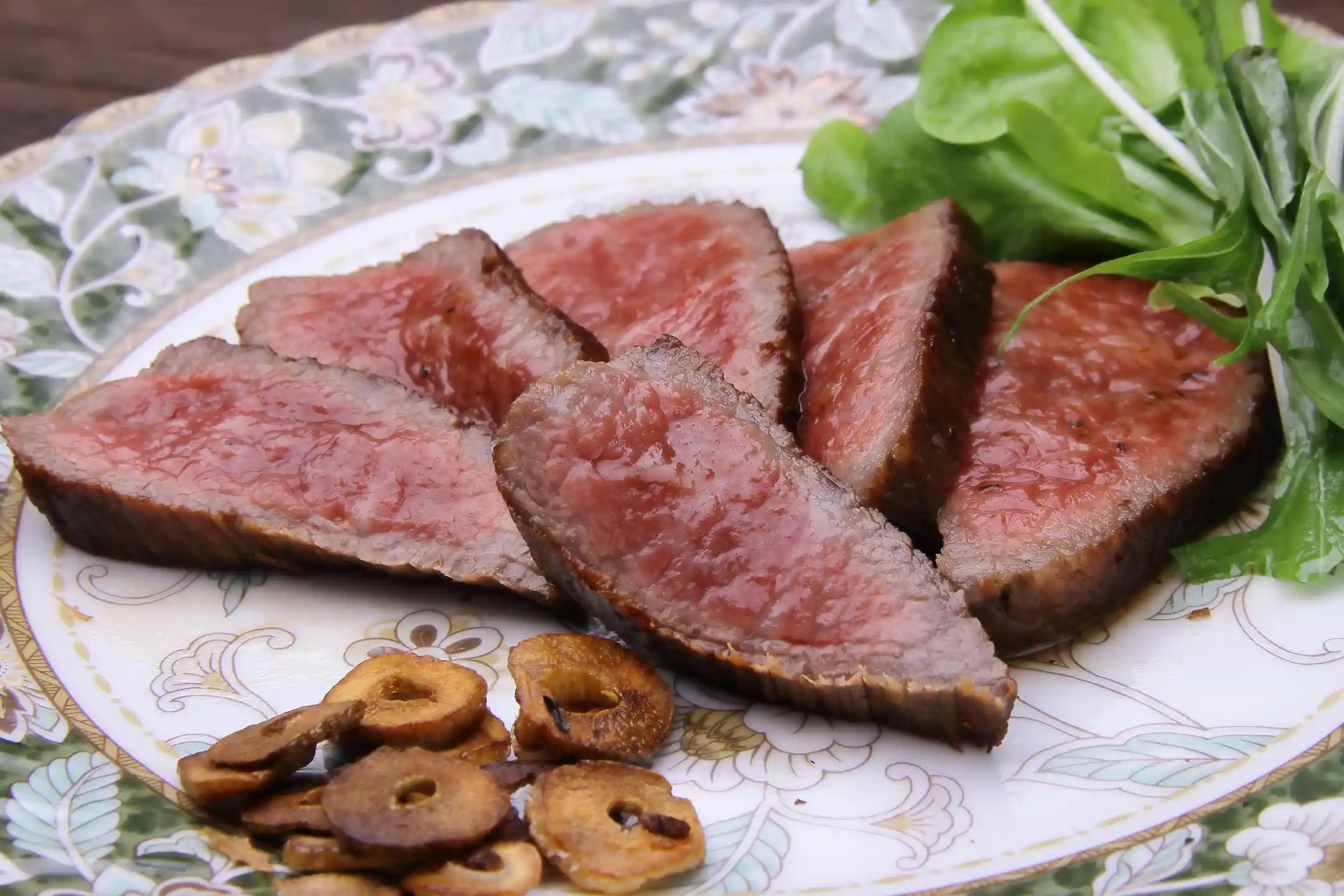Osaka’s food culture is so diverse that it has long been called “the Nation’s Kitchen.” From the dashi-based cuisine that blossomed during the city’s commercial heyday in the Edo period, to the seafood craftsmanship honed in its bustling markets, to the humble “konamon” dishes that fueled postwar recovery, layers of history have shaped Osaka’s gastronomy into something truly unique. A journey through Osaka is not just about eating—it’s about experiencing the city’s history, warmth, and spirit through its flavors.
What Makes Osaka Food Unique — History and Cultural Roots
Merchants of Edo and the Birth of “the Nation’s Kitchen”
During the Edo period, Osaka became the central hub where rice, seafood, and medicinal goods from all over Japan were gathered and traded. This is why it came to be called “the Nation’s Kitchen.” The establishment of Dojima Rice Market, Zakoba Fish Market, and Tenma Vegetable Market gave the city immense economic influence, with the kura storehouses of feudal domains depending on it.
The price of rice and goods in Osaka became the national standard, and merchants developed sophisticated bookkeeping systems and credit-based transactions (1) (2). This thriving commerce spurred the exchange of ingredients and cooking methods, giving birth to Osaka’s famously indulgent food culture, often described as “kuidaore”—to eat till you drop (3).
Buddhist Vegetarian Fare Meets Port-City Seafood
With meat considered taboo under Buddhist influence, vegetarian temple cuisine evolved to maximize the umami of kelp, soybeans, and vegetables. The large volumes of kelp brought in from Hokkaido by kitamaebune trading ships became a decisive foundation for Osaka’s dashi culture (4).
At the same time, Osaka Bay was a rich fishing ground known as uoniiwa (“fish garden”), yielding fresh sea bream, pike conger, and gizzard shad. When combined with kelp broth, these ingredients created a cuisine that was both light and profoundly layered. This harmony was enhanced by the fine blades forged by Sakai’s knife artisans, establishing the Osaka culinary ideal: to honor the ingredient rather than overpower it.
Konamon Culture and Postwar Recovery
In the aftermath of World War II, with rice scarce, ordinary people turned to inexpensive wheat flour. From penny street snacks called issen yoshoku, dishes like okonomiyaki—fortified with pork and cabbage—and takoyaki filled with diced octopus spread quickly from food stalls (5).
The sight of batter, chopped ingredients, and sweet-savory sauce sizzling on a hot griddle became a symbol of resilience, helping Osaka rise from black markets to prosperity. Okonomiyaki found its way into home kitchens, while takoyaki—blending dashi culture with street food spirit—became an emblem of Osaka itself. What began as survival cooking evolved into beloved soul food, inseparable from the city’s identity.

Best Food in Osaka — 10 Must-Try Dishes
Okonomiyaki — The Edible Canvas
Based on the humble issen yoshoku, okonomiyaki was reimagined after the war with pork, cabbage, and yam. This king of konamon is best experienced at Dotonbori’s Mizuno, where the batter is fluffy and creamy, or at Botejyu, which pioneered the now-standard mayonnaise topping. When kelp-and-bonito dashi-infused batter meets sweet-savory sauce on a hot iron plate, rising steam transforms your meal into a living canvas.
Takoyaki — Street-Side Alchemy
Invented in 1935 by Endo Tomekichi of Nishinari’s Aizuya, takoyaki captures plump octopus in dashi-rich batter and is grilled to golden spheres on copper plates. At traditional shops, they’re served without sauce to highlight the natural flavor of octopus and broth. Try hopping between Dotonbori’s Kukuru and Kougaryu, each with its own style and toppings.
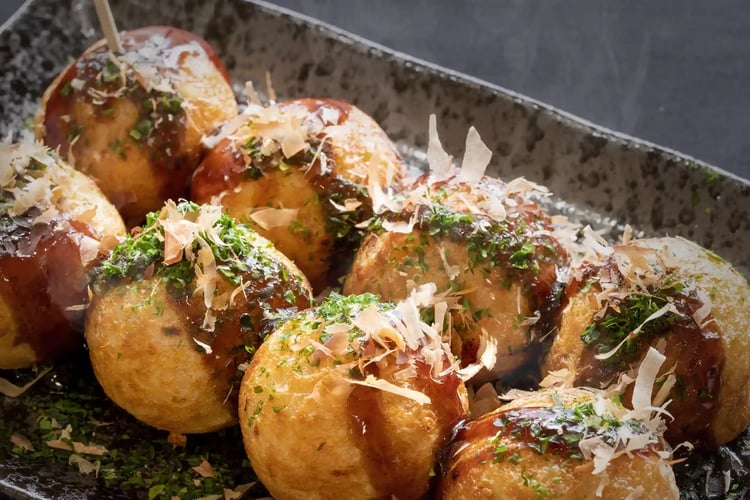
Kushikatsu — Golden Batter Bites
Created in 1929 at Shinsekai’s Daruma, kushikatsu offered inexpensive skewered beef. Today, the menu spans about 40 ingredients—from shrimp to lotus root—dipped just once in the shop’s special sauce. Paired with crisp cabbage and views of Tsutenkaku Tower, it’s a nostalgic taste of Osaka’s old downtown.
Kitsune Udon — Umami-Rich Comfort
First served in 1893 at Usamitei Matsubaya, kitsune udon features plump fried tofu simmered for three days until sweet and juicy, layered atop hot noodles. Its sweetness melds into kelp-and-bonito broth, wrapping you in warmth with every sip.
Pressed Sushi Traditions — Hakozushi and Battera
Merchant families prized pressed sushi for festive occasions. Hakozushi—layered with jeweled toppings like kinshi egg and simmered eel—was pressed in wooden molds, while battera, created at Temma’s Sushitsune in 1891, shaped mackerel and kelp into boat-shaped molds. Each reflects Osaka’s flair for refinement.
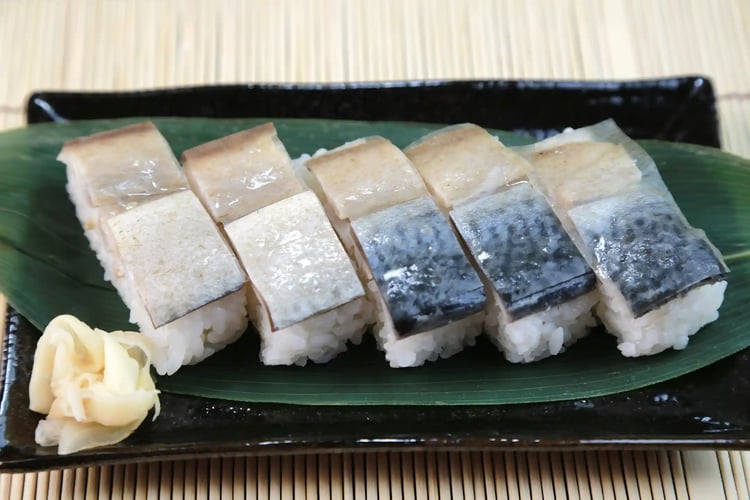
Whale Hotpot Heritage — Harihari Nabe
Popularized in 1967 by Sennichimae’s whale restaurant Tokuya, this hotpot pairs watercress (mizuna, whose crunch makes a “harihari” sound) with whale meat simmered in kelp broth. Finished with shichimi spice, it delivers deep warmth rooted in Osaka’s whale-eating traditions.
Beef Broth Soul Food — Nikusui
Born in the 1980s at Namba’s Chitose, nikusui came from a comedian’s offhand request: “Meat udon—without the udon.” What arrived was beef in clear broth, topped with a soft-boiled egg. Paired with kodama (egg over rice), it’s still the ultimate hangover cure and a showcase of Osaka’s dashi mastery.
Miso-Stewed Delight — Doteyaki
In the Taisho era, street stalls began simmering beef tendons in white miso and mirin, with the pot’s rim lined like earthen embankments (dote). Topped with scallions and shichimi, it’s a must-order side dish at Shinsekai kushikatsu joints.
Sweet Street Classics — Mitarashi Dango
Skewered rice dumplings char-grilled and dipped in thick soy-sugar glaze. A festive street treat at Tenjin Matsuri and Toka Ebisu, they carry the playful essence of Osaka’s matsuri. Sticky fingers are part of the joy.

Osaka Festive Dishes — Seasonal Traditions
Ehomaki sushi rolls for Setsubun began with merchants and courtesans praying for prosperity. For Boys’ Day in May, Kansai favors chimaki over kashiwa mochi, a contrast with Kanto culture. Sampling these foods gives you a taste of Osaka’s seasonal spirit.
Kuromon Market Complete Guide
Osaka has long been known as “the Nation’s Kitchen,” and Kuromon Market is its living symbol. Founded in the Edo period, the market has been feeding Osaka for over 200 years (1). In the heart of the Minami (Namba) district, its 580-meter arcade houses more than 150 shops, buzzing with life and rich aromas from early morning (2). Here you’ll find a true Osaka experience: chefs, locals, and travelers from around the world crossing paths, all drawn by the promise of kuidaore—to eat until you drop.
For curious travelers like you, Kuromon is not just a shopping street but a sensory and cultural classroom. Here’s how to explore it with both intellect and appetite.
.webp?width=750&height=500&name=Kuromon%20Market_s%20fresh%20catchseafood%20(Emphasizes%20the%20freshness).webp)
Seasonal Seafood and Wagyu Mastery
Each season brings its specialties. In summer, hamo (pike conger) is the highlight; in winter, fugu (pufferfish) reigns supreme. In fact, nearly 10% of Kuromon’s fishmongers specialize exclusively in fugu, a sign of how seriously Osaka takes it (3). To spot the best seafood, look for clear eyes and firm flesh—but don’t hesitate to ask the vendors themselves. Most are seasoned experts with decades of experience.
Wagyu butchers here stock A5-grade cuts and even entire heads of Japan’s most coveted beef, such as Matsusaka. At Nikuhoshi, you can taste this heritage directly as melt-in-your-mouth skewers grilled fresh before you (4). Arrive early in the morning to browse in relative calm, compare prices, and witness the freshest catches before the crowds.
Meet the Artisans
The real charm of Kuromon lies in its people and their craft. Many shops have stood for over a century, carrying traditions through generations (6). Watch knife masters fillet fish with fluid precision, sushi chefs shaping nigiri on the spot, or tamagoyaki specialists rolling steaming omelets right before your eyes. Every corner becomes a live kitchen and a stage for culinary heritage.
At Hamato, a long-established fugu restaurant, the third-generation owner still insists on using only domestically sourced tiger pufferfish weighing at least 1.5 kg—a devotion to quality passed down unwaveringly (7).
To make foreign guests feel welcome, the market has embraced change: free Wi-Fi, multilingual maps, and even English lessons for shop staff are now part of its fabric (8).
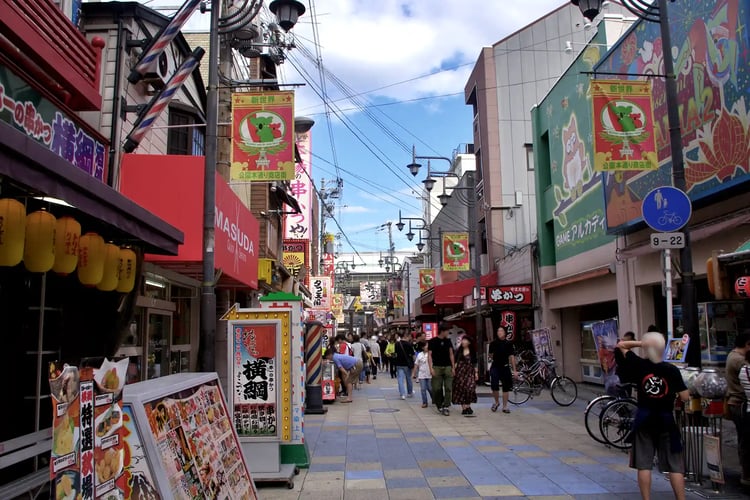
Sampling Etiquette
As you stroll, the scent of grilled skewers and fresh fruit tastings will tempt you. Keep a few etiquette points in mind: accept samples only when offered, eat skewered foods at designated spots or benches instead of while walking, and always dispose of trash in the shop’s bins. Early mornings are ideal if you want space to savor without the crush of the midday crowd (5).
Where to Eat in Osaka — From Michelin Stars to Hidden Alleyways
Osaka may be famous for its B-grade street food, but it is equally a city of contrasts: a place where Michelin-starred dining sits just blocks away from no-frills tachinomi standing bars. To dine in Osaka is to live the culture itself—whether you’re in a hushed kaiseki dining room or under red lanterns at a casual izakaya.
Michelin-Starred Kaiseki and Modern Fine Dining
If refined dining is what you’re after, Osaka’s Michelin scene will astonish you. The 2024 edition lists 85 starred restaurants: 3 with three stars, 10 with two, and 72 with one (1). That’s on par with the world’s greatest gastronomic capitals.
Unlike Kyoto’s classical elegance, Osaka’s kaiseki and kappo often embrace modern creativity. Seasonal ingredients appear in playful, inventive dishes, served in intimate counters or serene private rooms where conversation with the chef is part of the experience. It’s an invitation to rediscover the depth of Japanese cuisine in a contemporary light.
Retro Izakayas and Standing Bar Culture
Step off the main boulevards of Umeda or Namba and you’ll find yourself in deep Osaka. Narrow lanes like Ura-Namba pack over 100 tiny izakayas into a neon-lit warren (2). Under the glow of paper lanterns, strangers become friends over cups of sake, as steaming oden and crisp kushikatsu emerge from tiny kitchens.
Joining locals at a standing bar (tachinomi) is part of the charm. Just remember the etiquette: avoid arriving in large groups, keep your bags neatly by your feet, and don’t linger too long at one spot (3). This way you blend seamlessly into Osaka’s everyday rhythm.
Riverside Cafés and Coffee Culture
Dining in Osaka isn’t only about night. During the day, take a pause along the riverside cafés of Nakanoshima or Kitahama, where you can sip coffee on terraces overlooking historic architecture.
If you venture to Osaka Bay or Taisho district, you’ll find breezy waterfront cafés with ocean views. From nostalgic junkissa coffeehouses to trendy third-wave spots, the city’s café culture mirrors its openness and variety.
Dessert Bests in Osaka — Sweets and Café Culture
From Dotonbori Crêpes to Traditional Wagashi
In Minami’s backstreets, Crêperie Alcyon has drawn lines since 1999 with authentic French crepes, made with imported flour and Échiré butter inside a retro Western-style house (1). Nearby, Dotonbori Crepe, opened in 2018, makes waves with its “Osaka Sukkianen Crepe”—a flamboyant creation topped with cream puffs shaped like takoyaki and “OSAKA” meringues. Its pink façade and upstairs seating make it irresistible for Instagram (2).
But don’t miss Osaka’s classic sweets. Founded in 1858, Namiyoshian serves “aburi mitarashi dango,” flame-seared right before your eyes in a chic café setting (3). At Deiribashi Kintsubaya, a shop established in 1930, you can savor freshly grilled kintsuba—modest in size and sweetness, and a staple souvenir for locals (4).
Instagram-Ready Parfaits and Pancakes
At CAFE ANNON in Ura-Namba, fluffy soufflé pancakes with matcha ice cream and shiratama mochi are a hit with international visitors. By night, their parfaits transform into elaborate “adult desserts,” paired with drinks. Baked on copper griddles, the pancakes’ airy texture makes them worth the wait (5).
In Osaka, the sweet scene is layered—traditional wagashi and the latest dessert trends coexisting side by side, reflecting the city’s culinary depth as the Nation’s Kitchen.
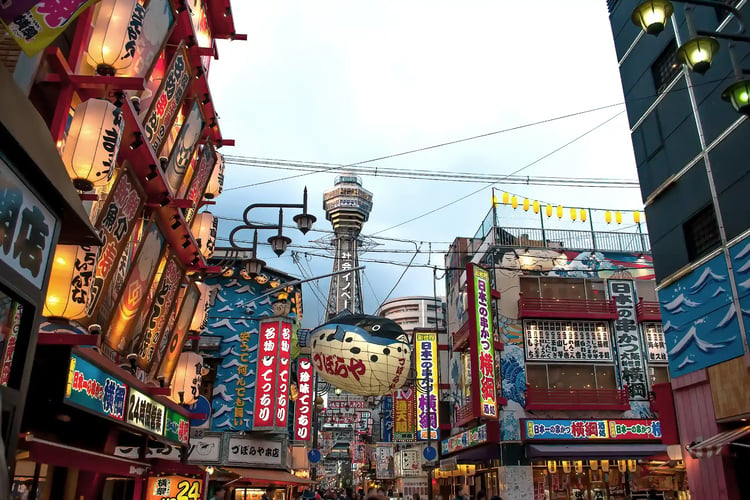
Hands-On Gourmet Tours and Workshops
Traditional Dashi Classes with Food Historians
The Ministry of Agriculture and Osaka Gas co-host seminars titled “Exploring the Charm of Dashi,” where you learn about Kansai’s broth culture through lectures and hands-on ichiban dashi practice. Hosted at Hug Museum’s professional kitchen, the 150-minute program even includes cooking dashi residue into tsukudani (6).
For English support, Sakura Cook offers small classes covering dashi, miso soup, and udon in approachable steps (7).
Food Photography and Styling Workshops
In Honmachi, the Japan Food Stylist Association runs a “Food Styling & Photography Course.” From tableware selection to mastering natural light, you’ll practice the “10 golden rules” to make your dishes camera-ready. Even with just a smartphone, you’ll walk away with skills that instantly elevate your travel photos (8).
Tea Ceremony and Wagashi Pairing
At Tea Ceremony Experience The Osaka in Dotonbori, you’ll whisk matcha under English guidance while savoring seasonal wagashi from long-established confectioners (9).
Meanwhile at Maikoya Osaka, workshops let you handcraft your own nerikiri sweets before donning kimono and stepping into an authentic tea room. Pairing your creation with freshly whisked tea becomes a memory in itself. No wonder it ranks high on TripAdvisor for cultural experiences (10).
Conclusion
Visiting Osaka is far more than tasting good food—it’s about entering a world where history, craft, and community converge. At Kuromon Market, you’ll sharpen your eye for seafood and wagyu while learning directly from seasoned artisans. You can savor modern kaiseki at Michelin-starred restaurants, then slip into back-alley izakayas to share oden and laughter with locals.
Add to that Osaka’s playful desserts, immersive workshops, and the ingenuity of konamon and dashi traditions, and you’ll see why the city continues to captivate travelers. Each dish tells a story of resilience, creativity, and joy.
So dive into Osaka with your senses wide open. Indulge, explore, and truly eat till you drop—that’s how you’ll come to know the Nation’s Kitchen at its deepest.
Author Bio



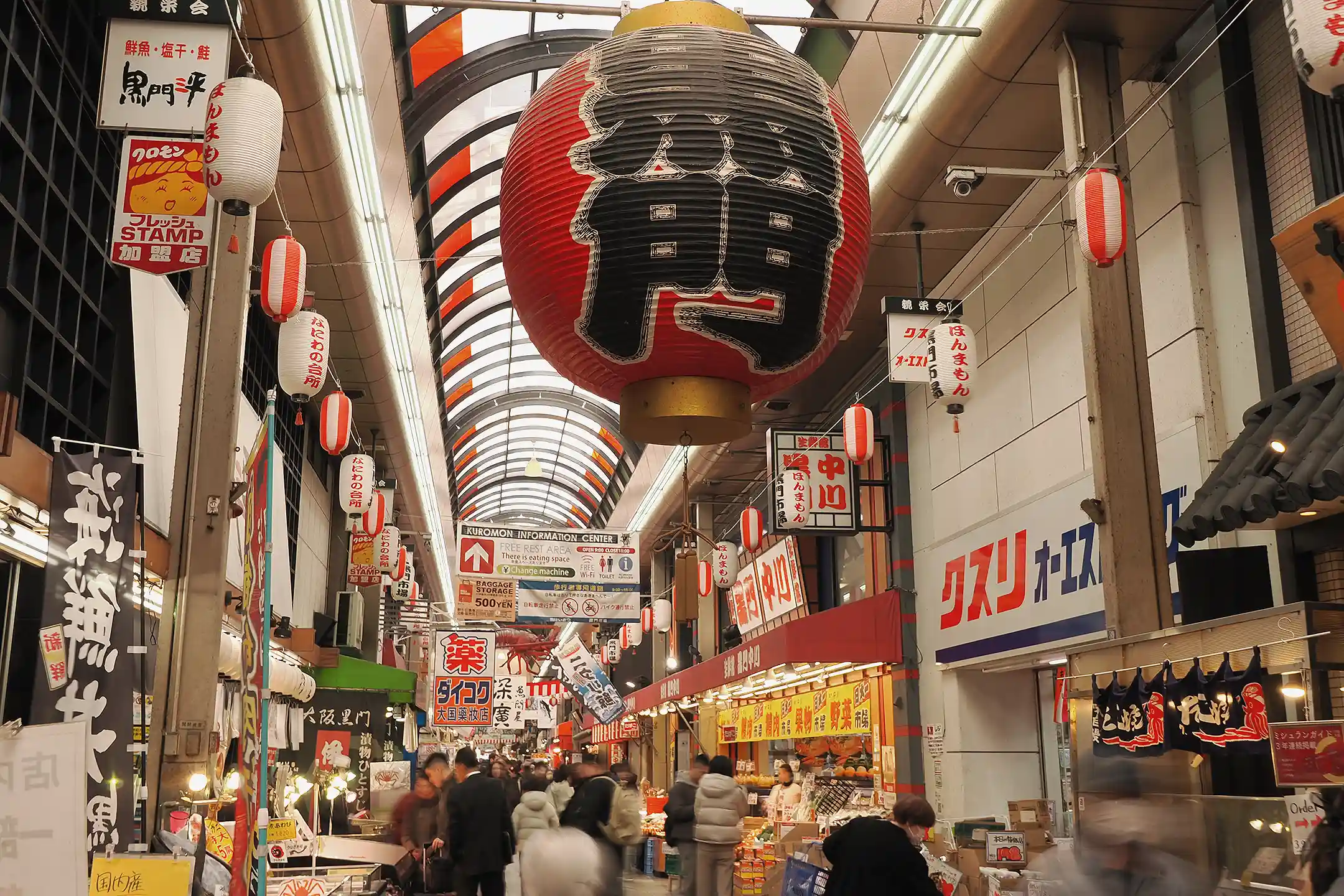

.webp)
